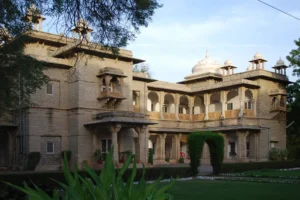
Preserving heritage isn’t a mere act of conserving old structures; it’s about sustaining a legacy and breathing new life into history while embracing modernity. In the realm of design, the art of sustaining legacy through restoration and adaptive reuse stands out as a testament to honouring the past while enriching the present. This legacy interweaves the past, present, and future, thus posing challenges when looking at temporal buildings through a timeless lens.
Historical significance & dilapidation
Centuries-old buildings, witnesses to the ebb and flow of time, face dilapidation as shifting usage patterns and ageing take their toll on them. The wear and tear become more evident, influenced by weather, structural strain, and a lack of regular maintenance, compromising the overall structural integrity.
A similar dilemma was faced in the case of Mayo College building in Ajmer and they enlisted the expertise of BASICS Architects to undertake the remodelling and conservation of its diverse boarding houses. These structures, some dating back to the 19th century, had fallen into a state of disrepair due to evolving usage patterns and the natural ageing process. The deterioration presented a need for skilled interventions. Simultaneously, the buildings needed to be modernised to suit the school’s current requirements without compromising their heritage character. Over a span of eight years, BASICS dedicated their efforts to the extensive renovation of eight houses, covering an expansive two lakh sq. ft. Additionally, the firm also played a pivotal role in designing new buildings. The team also contributed to infrastructure development across more than 300 acres of the campus.
Complexities of restoration
Restoration requires a delicate balance of extensive planning, seamless coordination between design and execution teams, and a nuanced understanding of adaptive reuse intricacies. Success is measured by structural improvements and by fostering a deep connection with heritage. Appreciation of restoration by administrators and users highlights its success in reconnecting with the past.
With Mayo College, careful planning, teamwork, and smooth coordination between BASICS’ design team and the execution team in Ajmer were the keys to the success of the project. The restoration of the houses received praise from the administration and the students, who found a renewed connection to their hostel lives in the revamped setup.
Blending old with new
Each historic building is a unique architectural gem, reflecting grandeur of the past. The challenge lies in preserving the individuality of each structure while infusing modern functionality seamlessly. It’s not just about refurbishing; it’s about ensuring these structures remain relevant in contemporary times.
Blending the old and the new was a challenge with the Mayo College project, which was handled with grace by the architects. Skilled local artisans, with their traditional know-how, played a crucial role in preserving and reviving the buildings. Special attention was given to the stonework, sourcing all stones from nearby mines in and around Ajmer, particularly utilising stone varieties. The proficiency of the stone masons helped identify suitable quarries, ensuring the same varieties were brought in for consistent colour and pattern. Metal jalis were replaced with stone replicas, mirroring the existing ones, some of which required repairs.
Adaptive restoration
As structures surpass their initial functions, adaptive reuse takes centre stage. The term ‘adaptive’ signals a shift from the original purpose, driven by evolving requirements, urging a transformation to fulfil contemporary needs. Adaptive restoration adds vitality to humble yet historically significant buildings, highlighting their enduring relevance.
Success of the Mayo College project was measured more than just in structural improvements. It was a renaissance, a rediscovery of hostel lives by the students. Each renovated boarding house, Jodhpur House, Colvin House, or Bharatpur House, displayed distinct architectural styles resonating with historical origins. The harmonious blend of old and new preserved each structure’s individuality while providing a modern, functional environment.
The challenges of such projects require meticulous planning, efficient coordination, and an understanding of historical and contemporary needs. The positive feedback from administrators and students alike is a testament to the project’s success, demonstrating how the complexities of adaptive reuse can be navigated to preserve the essence of each building.
Preserving heritage integrity
Local artisans and craftsmen, guardians of traditional skills, play a crucial role in meticulous conservation and restoration. The attention to detail used in the Mayo College exemplifies the dedication to preserving the essence of these structures.
In conclusion, sustaining legacy through design is not merely an aesthetic endeavour. It’s a commitment to preserving the past while enhancing the present. Restoration and adaptive reuse, exemplified by projects like Mayo College, showcase the transformative power of design in breathing new life into historical treasures, ensuring they remain a vital part of our shared legacy.




Leave a Reply
Your email is safe with us.